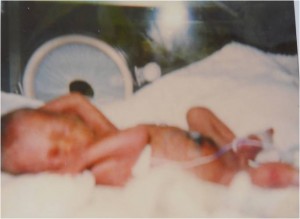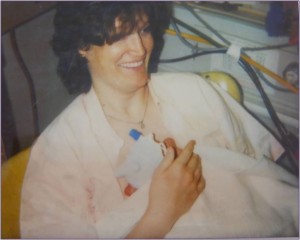This post originally appeared on the Kids’ Health Blog by Children’s Hospitals and Clinics of Minnesota.
Chris Clark was 23 weeks pregnant, on bed rest after her water broke, and had been given little hope of having a viable pregnancy.
A mom of three kids already and a natural protector, she wondered, if her child was born, was there something she could do to enhance his chance of survival? Bed rest gave Clark, who had a background in respiratory therapy, time to research.
She landed on an article in the magazine, Mothering, about kangaroo care in Colombia. Kangaroo care is the practice of holding your newborn baby skin to skin, which provides benefits to both the parents and the child. It helps premature babies develop. At the time – 1989 – kangaroo care wasn’t being practiced in the United States.
“I read the article through and thought, ‘Oh, my gosh, they’re holding babies skin to skin and the babies are doing better,’” she said. She contacted a researcher listed in the article, shared her condition with her and asked for medical literature supporting kangaroo care. The researcher sent the information overnight – she doubted Clark had much time before delivering.
Hours after getting the literature, Clark was rushed to United Hospital where she gave birth to Danny, who arrived at just 29 weeks on May 7, 1989. He was taken to the neonatal intensive care unit (NICU) at Children’s Hospitals and Clinics of Minnesota in St. Paul.

As soon as Danny was born, Clark started asking the neonatologist, Dr. Mark Mammel, if she could try kangaroo care.
“I was interested and also cautious. Maybe it’s growing up in the ’60s, but it seemed like a good idea. Parents holding babies – rocket science? No. But we all worried about the issue of temperature control, monitoring, airway obstruction, and so on,” Mammel said.
Clark persisted. “I asked every day if we could please, please try it,” she said.
Five days after giving birth on Mother’s Day, Clark held Danny for the first time. There were two crash carts and two resuscitation teams nearby – ready in case anything went wrong, she said.
“It was crazy. (Some of the staff) appeared terrified,” she said.
But the minute Clark started holding her son, terror and fear disappeared. She found only comfort and connection.
“It made me feel like his mom,” she said. “It was like I was in my own world with him.”
“Chris was very smart about the process. She initially saw the technique mentioned in a magazine…which I was familiar with as a fringe publication. It was not a great source for me to rely upon. Chris knew this!” Mammel said. “She gathered the actual medical literature – though there wasn’t much – and brought it to me and the group to review. Like all change in a NICU setting, a champion is needed to bring others along. I liked what I read – kangaroo care looked safe and probably beneficial, as well. So I became that champion, working with my partners and the nursing staff to pave the way for Chris to be the first.”
Initially, Clark spent about 30 minutes twice a day using kangaroo care.

Danny ultimately spent about nine weeks at Children’s. During that time, he needed nine blood transfusions, experienced numerous spells where he stopped breathing, and early on required a ventilator and 100 percent oxygen.
Prior to leaving, Danny required hernia surgery. Clark held her son for about 24 hours before the operation. The anesthesiologist visited afterwards to tell her Danny was the “most relaxed baby” he had worked with in his years of surgery.
Danny just turned 24. He’s run a marathon, has no lung or sight problems and is a singer/songwriter, Clark said.
“I believe Danny is who he is because of kangaroo care,” she said.
Kangaroo care is now a standard practice at Children’s and beyond.
“I’m a fairly strong advocate and a fighter for what I think is best for my kids. The fact that it has helped other kids feels like this might be the purpose of my life and, It’s enough,” Clark said. “I was blessed to have enough people that believed in and supported us.”
Today marks International Kangaroo Care Awareness Day – a day we celebrate at Children’s.
“We had always seen ourselves as ‘family-friendly’ – trying kangaroo care was a way for us to really walk the walk. We became recognized around the country for this, though it was never a focus of our research efforts. Others took on that task,” Mammel said. “Today, all our families benefit from this practice, which is as routine as turning on the lights in the morning.”